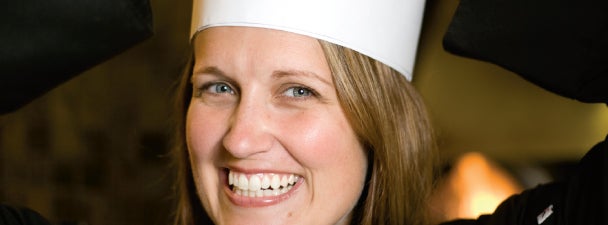
There was a time when celebrity chef would be considered somewhat of an oxymoron, when watching someone prepare a steak for someone else would be considered a kind of torture, when a primetime show about cooking would be considered a considerable risk – and an entire network? Forget it!
Those times, of course, are long gone. Thanks to Food Network programming, chefs like Emeril Lagasse, Rachael Ray and Bobby Flay have been catapulted from their private kitchens into millions of living rooms across America – and we, as consumers, can’t get enough. In fact, homemakers, teenagers, foodies and TV dinner–zappers alike seem to eat up whatever the Food Network puts out there for us.
“The popularity that Food Network programming has seen is a really interesting phenomenon – it’s become completely ingrained in who we are,” says Amanda Ruth-McSwain, assistant professor of communication, pointing out that there’s been a cultural shift not only in food and cooking (“what we eat now is so different from what we were eating just 10 years ago”), but also in how we see food and cooking. “What was once a necessary chore is now a form of entertainment.”
 Despite our huge appetite for this kind of entertainment, however, fewer and fewer Americans are preparing their own meals, which begs the question: What are we learning from Food Network – and how does that information translate into our everyday lives?
Despite our huge appetite for this kind of entertainment, however, fewer and fewer Americans are preparing their own meals, which begs the question: What are we learning from Food Network – and how does that information translate into our everyday lives?
That’s exactly what Ruth-McSwain hopes to find out. In a multi-phased study of Food Network programming, she and a colleague from Louisiana State University are looking at what is being communicated about food and health behaviors, what viewers are taking away from the programs and how their habits of buying, preparing and consuming of food are affected.
“We know that a good portion of Americans are watching these shows – so how can we capitalize on that?” considers Ruth-McSwain, whose background is in agricultural communication (“which basically translates to food-to-plate communication”). “Ultimately, we’re trying to find out how to use the popularity of these programs to communicate food safety. That’s our agenda – to communicate food safety practices to the general public.”
By first examining the food-safety messages within the programming and then establishing how consumers use the information they get from the programming, the researchers hope to have the evidence they need to earn a USDA grant for packaging food-safety messaging for the Food Network.
“That’s way, way down the line, but that’s the goal – to play out our agenda to fit these different kinds of shows,” says Ruth-McSwain, who will be presenting this fall the findings of the first phase at a national conference, Convergence and Society: Health and New Dimensions of Communication. “The good thing is, we’re taking this academic research approach and giving it a practical, real-world application. It’s all pretty exciting.”
After all, she notes, “Ten years ago, this wouldn’t even be something to discuss.”




